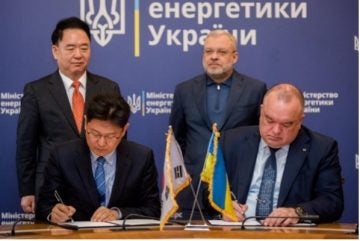
Ukraine’s nuclear utility Energoatom and South Korea’s Hyundai Engineering & Construction (E&C) have signed a memorandum of cooperation (MOC) on the design, construction and commissioning of new nuclear power units in Ukraine. The MOC was signed by Energoatom President Petro Kotin and Hyundai E&C Executive Vice President and Operations Director Choi Young in the presence of Ukraine’s Energy Minister Herman Halushchenko and South Korea’s Ambassador to Ukraine Kim Hyun-Tae.
Halushchenko said the agreements were important with respect to plans for the construction of new Westinghouse AP1000 units at the Khmelnitsky NPP (units 5&6). “It is important that, together with the Korean side, we sign this memorandum during the war and, without waiting for its end, move forward,” he noted. “I am confident that together we will build an energy industry in Ukraine that will meet the best global standards.”
The MOC follows on a letter of intent signed by the two companies in November 2023. In May 2022 Westinghouse and Hyundai E&C signed a strategic cooperation agreement to jointly participate in global AP1000 plant opportunities. In April, Energoatom held a ceremony marking the start of work at Khmelnitsky unit 5. Ukraine has agreed to buy heavy equipment that is ready to install. The two planned AP1000 units (5&6) are expected to use reactors currently in storage in the US. Energoatom said in December that “quite favourable conditions were obtained for the supply of equipment, which is already manufactured and ready for delivery”. The equipment had been manufactured for two new units at the US VC Summer NPP being built in South Carolina before the project was cancelled in the wake of Westinghouse filing for bankruptcy.
Ambassador Kim said the memorandum would “contribute to the development of Ukrainian-Korean cooperation in the nuclear industry, in particular, the exchange of experience in the field of nuclear technologies”. Kotin acknowledged South Korea’s nuclear energy and expertise in the nuclear industry. “Energoatom and Ukraine as a whole are interested in the development of our cooperation with the Hyundai company, which is one of the world leaders in this market,” he said. “South Korea is one of the leaders in the nuclear industry, its specialists have extensive experience in the expertise of nuclear facilities. Cooperation with Hyundai is very important for Energoatom. Interestingly, the equipment that we purchased from our partners – Westinghouse – for the construction of new units at the Khmelnitsky NPP was manufactured with the help of South Korean specialists. Thus, we are already actually working with South Korea in the field of nuclear energy and will only strengthen this work.”
Half of Ukraine’s energy is generated by its NPPs. Ukraine operates seven VVER-1000 reactors, including three at South Ukraine NPP, as well as two at Rivne NPP and the two at Khmelnitsky. Rivne NPP also operates two VVER-440 reactors. Six VVER-1000 units at the Zaporizhia NPP have been under Russian control since early March 2022. While all Ukraine’s operating reactors are of Soviet design, they are currently using nuclear fuel from the US.
Khmelnitsky’s first reactor was connected to the grid in 1987, but work on three others stopped in 1990 when unit 3 was 75% complete. Work on the second reactor restarted and it was connected to the grid in 2004 but units 3&4 remain unfinished. Reactors currently stored at Bulgaria’s cancelled Belene NPP are expected to be used to complete these units. However, talks with Bulgaria are still ongoing.
Specialists from Energoatom accompanied by Halushchenko recently visited the Belene site become familiar with the equipment as well as with the technical documentation of the reactors that are for sale. Halushchenko held talks with Bulgaria’s Minister of Energy Vladimir Malinov during which the prospects for an accelerated solution to the issue of selling reactors were discussed, according to Bulgaria’s National Electricity Company (NEK – Natsiunalnata Elektricheska Kompania). The Ukrainian side expressed hope of signing an agreement on the purchase of equipment in June. “We fully understand the importance of this process and will make every effort to speed it up as much as possible,” Malinov said. Ukraine had earlier expressed interest in buying the equipment, with financing for the deal expected to come from the European Union (EU). In January Bulgaria said it was waiting for “more sensible common EU stance on Ukraine”, particularly concerning financial support.






